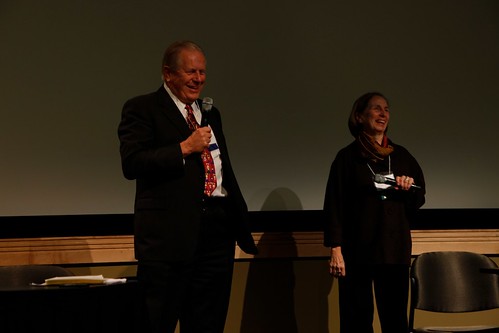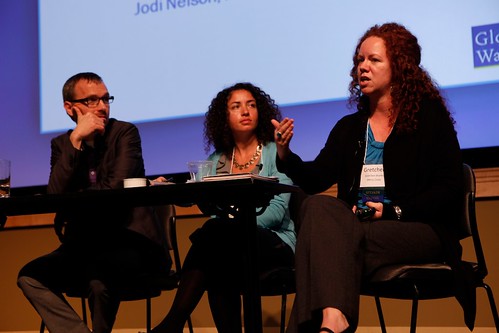Blog
Posted on December 10, 2010
As a hub of diverse and active international development players, the state of Washington is creating a model for collaboration in the global development sector, providing innovative strategies and cross-sector, cross-issue partnerships to build a better world. On November 15th and 16th, 2010, 430 members of the global development sector convened on the Microsoft campus in Redmond, Washington for Bridges to Breakthroughs: How partnerships and innovation are changing the world, a two-day conference hosted by Global Washington.
Bridges to Breakthroughs, Global Washington’s 2nd Annual Conference, brought a wide array of actors in the sector together to network and to learn from dynamic speakers, including representatives from USAID, Global Impact, Interaction, The Grameen Foundation, PATH, World Vision, The Bill & Melinda Gates Foundation, The United Nations Millennium Campaign, and many other innovative companies and organizations. Over the two days of the conference, these leaders discussed strategic approaches for strengthening cross-sector partnerships; promoting scientific and technological breakthroughs; and harnessing the collective leadership of the region’s scholars, entrepreneurs, business leaders, scientists, philanthropists, and advocates.
The two days of the conference were packed with great information about the most relevant issues facing the global development sector; attendees and speakers also explored how Global Washington can best achieve its mission to promote, support, and advocate on behalf of the development community in the state and beyond. The organization has put together a recap report summarizing each conference session, as well as overall trends and future steps for Global Washington and the development community. This conference will help put Washington State on the map as an example in partnerships and innovations that will hopefully be followed by other states in the near future.
To find out more about the conference, please explore the links below:
Read the conference recap report.
Watch the videos submitted for our Conference Showcase here.
Click here to see a video of the keynote delivered by Ambassador Verveer.
Click here for a Flickr photo collection from the conference.
Click here to read bios of dynamic Conference 2010 speakers.
Click here to read the blogs about the event discussions and speakers.
Click here to Read a recap of the News coverage of the event.
Posted on November 16, 2010
Susan Jeffords and Bill Clapp wrapped up the conference with a discussion of next steps and reflections for future Global Washington Conferences.

Jeffords voiced some key lessons for Global Washington, “people have different investments and priorities they bring to partnerships…[Global Washington] has an opportunity to construct places for these people to share these different stakes and articulate them.” She added that Global Washington can take a stronger role in facilitating these interactions and is also committed to helping small organizations have a voice in Washington DC among larger organizations while gaining access to larger types of partnerships. Also, Jeffords commented on the repeated theme of improving conditions for global women and girls. She asked, “that everyone should walk out of this room and think of how to incorporate a focus on women and girls in everything we do to really build up a better world.”
Clapp concluded, the “quality of the dialogue has been a step up from last year” and “this has been an extraordinary two days.”
Submitted by Nina Carduner
Posted on November 16, 2010
The panel discussion focused on the growing pressure in the development sector for effective monitoring and evaluation in measuring the successful impact of of programs from aid and relief work to development. Much of impact evaluation often doesn’t take into account the various challenges that successful implementation of programs face on the ground and the panel discussed the challenges as well as some best practices for large and small organizations to move forward with useful evaluation methods.
Moderator Jodi Nelson, of the Bill & Melinda Gates Foundation, opened the panel with a quote pulled from a recent news article asking, “how do we ask the do gooders to prove they really do good,” which underscores the growing need and desire to hold non-profits, NGOs, and aid programs accountable to their goals and good intentions. In the past, NGOs were thought to be exempt from traditional oversight, Nelson explained. “Intention alone was considered enough proof to prove they were accomplishing their goals.”

After fielding many questions from the audience, the panel took turns in the informal discussion. Holta Trandafili, of World Vision International, discussed the shift towards applying lessons learned in the past decades and how impact evaluation can help tailor future programs for more effective implementation and greater impact. There was some question in the audience about whether evaluation was important for small organizations, which Trandafili affirmed and emphasized the need to define the type of evaluation for each organization. She explained that it’s important for small organizations to focus on asking the questions, “can we actually measure our impact and when we do, what are we going to do with what we find?” Gretchen Shanks, from Mercy Corps, added that monitoring may be more efficient for short term programs like relief and crisis programs, while long term programs really do require more evaluation to stay in line with their missions and consistently respond to the data for improvement. One of the ways that Mercy Corps champions this is by looking at the “theory of change” that is motivating their programs. While there is not one set of tools that is ideal for community mobilization in these programs, continuous resource allocation, building in participatory channels for the communities that are being served, and monitoring processes are key.
Innovation was also discussed by the panelists. Many times, the funding environment for non-profits and NGOs does not create space for failure. The environment is competitive and the structure of funding and project cycles disincentivizes monitoring and evaluation. Shanks expressed, “we feel like we can’t talk about failure openly,” which makes innovation difficult. Nigel Biggar, of Grameen Foundation, shared that successful innovation will come when experimental programs require less cost and time to be evaluated. Doing so will enable ineffective programs to fail quickly without much cost, “so we can learn and build on those quickly,” and lead the way for more innovation.
Submitted by Nina Carduner

